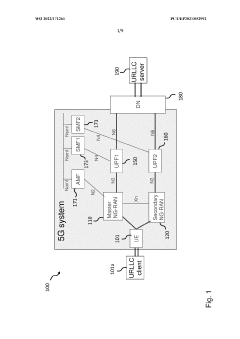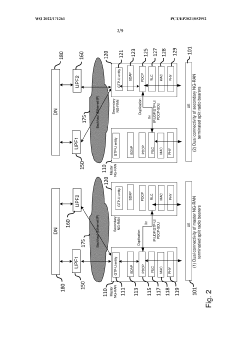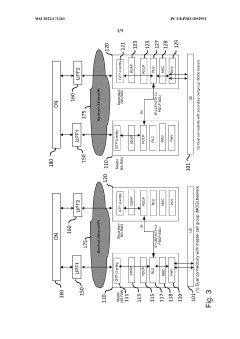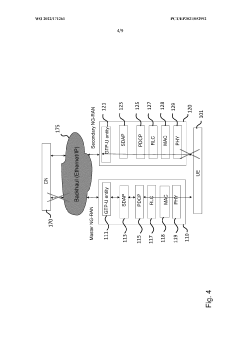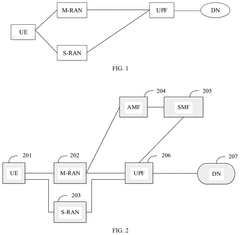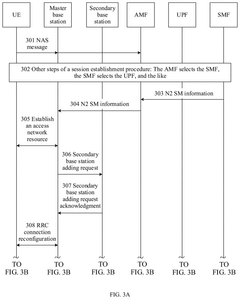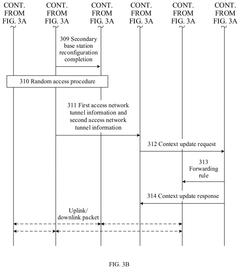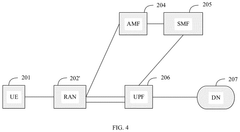Exploring the Role of 5G UC in Advancing Smart Traffic Management
JUL 18, 20259 MIN READ
Generate Your Research Report Instantly with AI Agent
Patsnap Eureka helps you evaluate technical feasibility & market potential.
5G UC in Smart Traffic: Background and Objectives
The evolution of smart traffic management systems has been a critical focus in urban development, aiming to enhance road safety, reduce congestion, and improve overall transportation efficiency. As cities grow and vehicle populations increase, traditional traffic management methods have proven inadequate in addressing the complex challenges of modern urban mobility. The advent of 5G Ultra-Capacity (UC) technology presents a transformative opportunity to revolutionize smart traffic management systems.
5G UC, with its ultra-high bandwidth, low latency, and massive device connectivity, offers unprecedented capabilities for real-time data collection, processing, and communication in traffic management applications. This technology enables a new era of intelligent transportation systems that can adapt dynamically to changing traffic conditions, optimize traffic flow, and enhance road safety through advanced sensing and control mechanisms.
The primary objective of integrating 5G UC into smart traffic management is to create a highly responsive, data-driven ecosystem that can significantly improve urban mobility. By leveraging the enhanced capabilities of 5G networks, traffic management systems can process vast amounts of data from various sources, including vehicles, infrastructure sensors, and pedestrian devices, in real-time. This allows for more accurate traffic prediction, efficient route optimization, and immediate incident response.
Historical developments in traffic management technology have progressed from simple traffic light systems to more advanced solutions incorporating cameras, sensors, and centralized control centers. However, these systems often operate with limited real-time capabilities and struggle to handle the increasing complexity of urban traffic patterns. The introduction of 5G UC marks a significant leap forward, enabling a new generation of intelligent traffic management solutions.
The technological trajectory of smart traffic management systems is closely aligned with advancements in communication technologies, data analytics, and artificial intelligence. As 5G UC networks become more prevalent, they are expected to facilitate the widespread adoption of connected and autonomous vehicles, smart infrastructure, and advanced traffic management algorithms. This convergence of technologies promises to create a more efficient, safe, and sustainable urban transportation environment.
In the context of smart cities and Internet of Things (IoT) initiatives, 5G UC-enabled traffic management systems represent a crucial component of future urban infrastructure. The technology's potential to support massive machine-type communications (mMTC) and ultra-reliable low-latency communications (URLLC) makes it particularly well-suited for the complex, time-sensitive requirements of modern traffic management applications.
5G UC, with its ultra-high bandwidth, low latency, and massive device connectivity, offers unprecedented capabilities for real-time data collection, processing, and communication in traffic management applications. This technology enables a new era of intelligent transportation systems that can adapt dynamically to changing traffic conditions, optimize traffic flow, and enhance road safety through advanced sensing and control mechanisms.
The primary objective of integrating 5G UC into smart traffic management is to create a highly responsive, data-driven ecosystem that can significantly improve urban mobility. By leveraging the enhanced capabilities of 5G networks, traffic management systems can process vast amounts of data from various sources, including vehicles, infrastructure sensors, and pedestrian devices, in real-time. This allows for more accurate traffic prediction, efficient route optimization, and immediate incident response.
Historical developments in traffic management technology have progressed from simple traffic light systems to more advanced solutions incorporating cameras, sensors, and centralized control centers. However, these systems often operate with limited real-time capabilities and struggle to handle the increasing complexity of urban traffic patterns. The introduction of 5G UC marks a significant leap forward, enabling a new generation of intelligent traffic management solutions.
The technological trajectory of smart traffic management systems is closely aligned with advancements in communication technologies, data analytics, and artificial intelligence. As 5G UC networks become more prevalent, they are expected to facilitate the widespread adoption of connected and autonomous vehicles, smart infrastructure, and advanced traffic management algorithms. This convergence of technologies promises to create a more efficient, safe, and sustainable urban transportation environment.
In the context of smart cities and Internet of Things (IoT) initiatives, 5G UC-enabled traffic management systems represent a crucial component of future urban infrastructure. The technology's potential to support massive machine-type communications (mMTC) and ultra-reliable low-latency communications (URLLC) makes it particularly well-suited for the complex, time-sensitive requirements of modern traffic management applications.
Market Demand Analysis for 5G-Enabled Traffic Solutions
The market demand for 5G-enabled traffic solutions is experiencing significant growth, driven by the increasing need for efficient and intelligent transportation systems in urban areas. As cities worldwide grapple with traffic congestion, road safety concerns, and environmental issues, the integration of 5G technology in traffic management offers promising solutions to these challenges.
The global smart transportation market is projected to expand rapidly, with 5G playing a crucial role in this growth. The enhanced capabilities of 5G, such as ultra-low latency, high bandwidth, and massive device connectivity, are enabling more sophisticated and responsive traffic management systems. This technology allows for real-time data collection, analysis, and decision-making, which are essential for optimizing traffic flow and improving road safety.
One of the key drivers of market demand is the push for smart city initiatives across the globe. Governments and municipalities are increasingly recognizing the potential of 5G-enabled traffic solutions to reduce congestion, lower emissions, and enhance overall urban mobility. This has led to increased investment in smart traffic infrastructure and the development of intelligent transportation systems.
The automotive industry is also a significant contributor to the growing demand for 5G-enabled traffic solutions. With the rise of connected and autonomous vehicles, there is a pressing need for robust communication networks that can support vehicle-to-vehicle (V2V) and vehicle-to-infrastructure (V2I) communications. 5G technology provides the necessary infrastructure to enable these advanced automotive applications, further driving market demand.
Public transportation systems are another sector showing strong interest in 5G-enabled traffic solutions. Transit authorities are looking to improve service reliability, optimize routes, and enhance passenger experiences through real-time data analytics and predictive maintenance enabled by 5G networks. This trend is expected to contribute significantly to market growth in the coming years.
The logistics and freight industry is also fueling demand for 5G-enabled traffic management systems. With the rise of e-commerce and the need for efficient last-mile delivery, companies are seeking solutions that can optimize route planning, reduce delivery times, and improve overall supply chain efficiency. 5G technology offers the potential to revolutionize logistics operations through enhanced tracking, real-time fleet management, and automated delivery systems.
Despite the growing market demand, there are challenges that need to be addressed. These include the high costs associated with 5G infrastructure deployment, concerns about data privacy and security, and the need for standardization across different systems and regions. However, the potential benefits of 5G-enabled traffic solutions are expected to outweigh these challenges, driving continued market growth and innovation in the smart transportation sector.
The global smart transportation market is projected to expand rapidly, with 5G playing a crucial role in this growth. The enhanced capabilities of 5G, such as ultra-low latency, high bandwidth, and massive device connectivity, are enabling more sophisticated and responsive traffic management systems. This technology allows for real-time data collection, analysis, and decision-making, which are essential for optimizing traffic flow and improving road safety.
One of the key drivers of market demand is the push for smart city initiatives across the globe. Governments and municipalities are increasingly recognizing the potential of 5G-enabled traffic solutions to reduce congestion, lower emissions, and enhance overall urban mobility. This has led to increased investment in smart traffic infrastructure and the development of intelligent transportation systems.
The automotive industry is also a significant contributor to the growing demand for 5G-enabled traffic solutions. With the rise of connected and autonomous vehicles, there is a pressing need for robust communication networks that can support vehicle-to-vehicle (V2V) and vehicle-to-infrastructure (V2I) communications. 5G technology provides the necessary infrastructure to enable these advanced automotive applications, further driving market demand.
Public transportation systems are another sector showing strong interest in 5G-enabled traffic solutions. Transit authorities are looking to improve service reliability, optimize routes, and enhance passenger experiences through real-time data analytics and predictive maintenance enabled by 5G networks. This trend is expected to contribute significantly to market growth in the coming years.
The logistics and freight industry is also fueling demand for 5G-enabled traffic management systems. With the rise of e-commerce and the need for efficient last-mile delivery, companies are seeking solutions that can optimize route planning, reduce delivery times, and improve overall supply chain efficiency. 5G technology offers the potential to revolutionize logistics operations through enhanced tracking, real-time fleet management, and automated delivery systems.
Despite the growing market demand, there are challenges that need to be addressed. These include the high costs associated with 5G infrastructure deployment, concerns about data privacy and security, and the need for standardization across different systems and regions. However, the potential benefits of 5G-enabled traffic solutions are expected to outweigh these challenges, driving continued market growth and innovation in the smart transportation sector.
Current State and Challenges of 5G UC in Traffic Management
The current state of 5G UC (Ultra-Capacity) in traffic management is characterized by significant advancements and promising potential, yet it also faces several challenges. 5G UC technology has demonstrated its capability to revolutionize smart traffic management systems by providing ultra-fast, low-latency connectivity and massive device support.
In terms of deployment, major cities and urban areas have begun integrating 5G UC into their traffic management infrastructure. This includes the installation of 5G-enabled sensors, cameras, and communication devices at intersections, along highways, and in public transportation systems. These implementations have shown improvements in real-time traffic monitoring, adaptive signal control, and vehicle-to-infrastructure (V2I) communication.
One of the key advantages of 5G UC in traffic management is its ability to process and transmit large volumes of data in near real-time. This has enabled more accurate traffic prediction models, faster incident detection, and more efficient routing of emergency vehicles. Additionally, the low latency of 5G UC has proven crucial for applications requiring immediate response, such as collision avoidance systems and autonomous vehicle coordination.
However, the widespread adoption of 5G UC in traffic management faces several challenges. The most significant hurdle is the high cost associated with infrastructure upgrades and device compatibility. Many existing traffic management systems rely on older technologies, and the transition to 5G UC requires substantial investment in new hardware and software.
Another challenge is the need for standardization and interoperability. As different cities and regions adopt 5G UC solutions, ensuring seamless communication and data exchange between various systems and devices becomes crucial. The lack of unified standards can lead to fragmented implementations and reduced effectiveness of cross-jurisdictional traffic management efforts.
Security and privacy concerns also pose significant challenges. The increased connectivity and data exchange in 5G UC-enabled traffic systems create potential vulnerabilities to cyber attacks. Protecting sensitive traffic data and ensuring the integrity of traffic control systems are paramount concerns that require ongoing attention and investment.
Furthermore, the full potential of 5G UC in traffic management is yet to be realized due to limited coverage. While urban areas are seeing rapid deployment, suburban and rural regions lag behind, creating disparities in traffic management capabilities across different geographical areas.
Lastly, there is a need for skilled professionals who can develop, implement, and maintain 5G UC-based traffic management systems. The shortage of expertise in this specialized field can slow down adoption and innovation in smart traffic management solutions.
In terms of deployment, major cities and urban areas have begun integrating 5G UC into their traffic management infrastructure. This includes the installation of 5G-enabled sensors, cameras, and communication devices at intersections, along highways, and in public transportation systems. These implementations have shown improvements in real-time traffic monitoring, adaptive signal control, and vehicle-to-infrastructure (V2I) communication.
One of the key advantages of 5G UC in traffic management is its ability to process and transmit large volumes of data in near real-time. This has enabled more accurate traffic prediction models, faster incident detection, and more efficient routing of emergency vehicles. Additionally, the low latency of 5G UC has proven crucial for applications requiring immediate response, such as collision avoidance systems and autonomous vehicle coordination.
However, the widespread adoption of 5G UC in traffic management faces several challenges. The most significant hurdle is the high cost associated with infrastructure upgrades and device compatibility. Many existing traffic management systems rely on older technologies, and the transition to 5G UC requires substantial investment in new hardware and software.
Another challenge is the need for standardization and interoperability. As different cities and regions adopt 5G UC solutions, ensuring seamless communication and data exchange between various systems and devices becomes crucial. The lack of unified standards can lead to fragmented implementations and reduced effectiveness of cross-jurisdictional traffic management efforts.
Security and privacy concerns also pose significant challenges. The increased connectivity and data exchange in 5G UC-enabled traffic systems create potential vulnerabilities to cyber attacks. Protecting sensitive traffic data and ensuring the integrity of traffic control systems are paramount concerns that require ongoing attention and investment.
Furthermore, the full potential of 5G UC in traffic management is yet to be realized due to limited coverage. While urban areas are seeing rapid deployment, suburban and rural regions lag behind, creating disparities in traffic management capabilities across different geographical areas.
Lastly, there is a need for skilled professionals who can develop, implement, and maintain 5G UC-based traffic management systems. The shortage of expertise in this specialized field can slow down adoption and innovation in smart traffic management solutions.
Existing 5G UC Solutions for Traffic Management
01 5G Ultra Capacity Network Architecture
5G Ultra Capacity (UC) refers to an advanced network architecture that utilizes mid-band and high-band spectrum to deliver enhanced capacity and performance. This architecture enables faster data speeds, lower latency, and improved network efficiency compared to standard 5G networks. It incorporates advanced technologies such as massive MIMO, beamforming, and carrier aggregation to maximize spectrum utilization and network capacity.- 5G Ultra Capacity Network Architecture: 5G Ultra Capacity (UC) refers to an advanced network architecture that utilizes mid-band and high-band spectrum to deliver enhanced capacity and performance. This architecture enables faster data speeds, lower latency, and improved network efficiency compared to standard 5G networks. It incorporates advanced technologies such as massive MIMO, beamforming, and carrier aggregation to maximize spectrum utilization and network capacity.
- Resource Allocation and Management in 5G UC: Efficient resource allocation and management are crucial for 5G UC networks to optimize performance. This includes dynamic spectrum allocation, intelligent scheduling algorithms, and adaptive power control mechanisms. These techniques ensure optimal utilization of network resources, load balancing, and quality of service management across different user devices and applications in high-capacity scenarios.
- 5G UC Device and Infrastructure Integration: Integration of 5G UC capabilities into user devices and network infrastructure is essential for leveraging ultra-capacity features. This involves developing compatible chipsets, antennas, and software solutions that can support high-frequency bands and advanced 5G technologies. It also includes the deployment of small cells, distributed antenna systems, and edge computing resources to enhance network coverage and capacity in dense urban areas.
- Security and Privacy in 5G UC Networks: Ensuring robust security and privacy in 5G UC networks is critical due to the increased connectivity and data throughput. This involves implementing advanced encryption techniques, secure authentication mechanisms, and network slicing to isolate sensitive data and applications. Additionally, it includes developing AI-driven threat detection systems and privacy-preserving protocols to protect user data and network integrity in high-capacity environments.
- Energy Efficiency in 5G UC Deployments: Improving energy efficiency in 5G UC deployments is crucial for sustainable network operation. This involves developing energy-aware network management algorithms, implementing sleep modes for base stations during low-traffic periods, and utilizing renewable energy sources for powering network infrastructure. Advanced power amplifier designs and intelligent cooling systems are also employed to reduce energy consumption in high-capacity network elements.
02 Resource Allocation and Management in 5G UC
Efficient resource allocation and management are crucial for 5G UC networks to optimize performance. This includes dynamic spectrum allocation, intelligent scheduling algorithms, and adaptive power control mechanisms. These techniques ensure that network resources are utilized effectively to meet varying user demands and traffic patterns, ultimately enhancing the overall capacity and quality of service in 5G UC networks.Expand Specific Solutions03 5G UC Device and Infrastructure Integration
The integration of 5G UC-capable devices and network infrastructure is essential for realizing the full potential of Ultra Capacity networks. This involves the development of advanced chipsets, antennas, and radio frequency components that can support higher frequency bands and advanced signal processing techniques. Additionally, it requires the deployment of dense small cell networks and the upgrade of existing macro cell sites to support 5G UC capabilities.Expand Specific Solutions04 5G UC Security and Privacy Enhancements
As 5G UC networks handle increased data traffic and support more critical applications, robust security and privacy measures are essential. This includes advanced encryption techniques, secure authentication protocols, and network slicing to isolate sensitive data. Additionally, enhanced threat detection and mitigation mechanisms are implemented to protect against potential vulnerabilities and cyber attacks in the high-capacity network environment.Expand Specific Solutions05 5G UC Performance Optimization and Quality of Service
Continuous optimization of 5G UC networks is crucial to maintain high performance and quality of service. This involves advanced network monitoring tools, AI-driven predictive maintenance, and self-optimizing network (SON) technologies. These solutions help identify and resolve network issues proactively, optimize resource allocation in real-time, and ensure consistent high-quality user experiences across various applications and services supported by 5G UC networks.Expand Specific Solutions
Key Players in 5G UC and Smart Traffic Industry
The 5G UC technology for smart traffic management is in its early development stage, with significant market potential as cities worldwide seek to improve urban mobility. The market size is expected to grow rapidly as more cities adopt smart traffic solutions. Technologically, 5G UC is still evolving, with major players like Samsung, IBM, ZTE, and LG Electronics driving innovation. These companies are investing heavily in R&D to enhance 5G UC capabilities for traffic management applications. The competitive landscape is dynamic, with telecom giants like SK Telecom and DISH Wireless also entering the market, indicating a growing interest in this technology across various sectors.
International Business Machines Corp.
Technical Solution: IBM's approach to 5G UC in smart traffic management leverages their expertise in AI and cloud computing. Their solution utilizes the IBM Watson IoT platform to process and analyze data from various traffic sensors and cameras. IBM has developed a cognitive traffic management system that uses machine learning to adapt to changing traffic patterns and predict potential issues[10]. Their solution incorporates blockchain technology for secure and transparent data sharing among different stakeholders in the traffic ecosystem. IBM's system also includes advanced visualization tools for traffic control centers, enabling operators to make informed decisions quickly. Additionally, they have implemented edge computing solutions to handle time-sensitive traffic management tasks, such as emergency vehicle routing and accident detection[11].
Strengths: Advanced AI and analytics capabilities, strong cloud infrastructure, and extensive experience in large-scale system integration. Weaknesses: May face challenges in hardware-specific aspects of 5G implementation and potential difficulties in adapting to rapidly changing 5G standards.
ZTE Corp.
Technical Solution: ZTE's 5G UC solution for smart traffic management emphasizes high-bandwidth, low-latency communication for real-time traffic control. Their system utilizes advanced beamforming techniques to ensure reliable connectivity in dense urban environments[7]. ZTE has developed a distributed architecture that combines edge computing with cloud-based analytics to process vast amounts of traffic data efficiently. Their solution includes AI-driven congestion prediction and intelligent routing algorithms to optimize traffic flow. ZTE has also implemented vehicle-to-infrastructure (V2I) communication protocols to support autonomous and connected vehicles[8]. Additionally, they offer a comprehensive smart city platform that integrates traffic management with other urban services for holistic city planning and management[9].
Strengths: Strong presence in emerging markets, cost-effective solutions, and integrated smart city approach. Weaknesses: May face regulatory challenges in some Western markets and potential concerns about data security and privacy.
Core Innovations in 5G UC for Smart Traffic Systems
Devices, systems and methods for urllc in a 5g communication network
PatentWO2022171261A1
Innovation
- The implementation of redundant data paths using a network entity that establishes dual PDU sessions with primary and secondary next-generation radio access networks (NG-RANs), employing packet duplication and elimination entities to ensure data reliability and availability by duplicating and eliminating Ethernet frames or DetNet-IP packets across independent paths.
Packet Transmission Method, Apparatus, and System
PatentPendingUS20250159749A1
Innovation
- A packet transmission method where a session management function (SMF) network element sends downlink forwarding rules to a user plane function (UPF) network element, instructing it to replicate downlink packets of a specific service and send them through two distinct paths, thereby enhancing the reliability of packet transmission.
Regulatory Framework for 5G in Transportation
The regulatory framework for 5G in transportation is a critical aspect of implementing advanced smart traffic management systems. As 5G technology continues to evolve and expand, governments and regulatory bodies worldwide are developing comprehensive guidelines to ensure its safe and effective integration into transportation infrastructure.
At the federal level, many countries have established dedicated agencies or task forces to oversee the deployment of 5G in transportation. These entities are responsible for creating standards, allocating spectrum, and addressing security concerns. For instance, the United States Federal Communications Commission (FCC) has designated specific frequency bands for 5G use in transportation, while the National Highway Traffic Safety Administration (NHTSA) is developing safety regulations for connected vehicles.
Internationally, organizations such as the International Telecommunication Union (ITU) are working to harmonize 5G standards across borders, facilitating seamless connectivity for cross-border transportation. The European Union has also implemented the 5G Action Plan, which includes specific provisions for connected and automated mobility.
On a more granular level, local and regional authorities are adapting existing traffic laws and regulations to accommodate 5G-enabled smart traffic management systems. This includes updating policies on data privacy, cybersecurity, and liability in the context of connected and autonomous vehicles.
One of the key challenges in developing a regulatory framework for 5G in transportation is balancing innovation with safety and security. Regulators must ensure that 5G networks are resilient against cyber threats while also allowing for the rapid deployment of new technologies. To address this, many countries are implementing risk-based approaches to regulation, focusing on outcomes rather than prescriptive rules.
Another important aspect of the regulatory framework is the management of data generated by 5G-enabled transportation systems. Governments are establishing guidelines for data collection, storage, and sharing, with a focus on protecting personal information while enabling the use of aggregated data for traffic optimization and urban planning.
As 5G technology continues to advance, regulatory frameworks will need to remain flexible and adaptable. Many jurisdictions are adopting iterative approaches to regulation, allowing for periodic reviews and updates to keep pace with technological developments. This agile regulatory environment is crucial for fostering innovation in smart traffic management while maintaining public safety and trust.
At the federal level, many countries have established dedicated agencies or task forces to oversee the deployment of 5G in transportation. These entities are responsible for creating standards, allocating spectrum, and addressing security concerns. For instance, the United States Federal Communications Commission (FCC) has designated specific frequency bands for 5G use in transportation, while the National Highway Traffic Safety Administration (NHTSA) is developing safety regulations for connected vehicles.
Internationally, organizations such as the International Telecommunication Union (ITU) are working to harmonize 5G standards across borders, facilitating seamless connectivity for cross-border transportation. The European Union has also implemented the 5G Action Plan, which includes specific provisions for connected and automated mobility.
On a more granular level, local and regional authorities are adapting existing traffic laws and regulations to accommodate 5G-enabled smart traffic management systems. This includes updating policies on data privacy, cybersecurity, and liability in the context of connected and autonomous vehicles.
One of the key challenges in developing a regulatory framework for 5G in transportation is balancing innovation with safety and security. Regulators must ensure that 5G networks are resilient against cyber threats while also allowing for the rapid deployment of new technologies. To address this, many countries are implementing risk-based approaches to regulation, focusing on outcomes rather than prescriptive rules.
Another important aspect of the regulatory framework is the management of data generated by 5G-enabled transportation systems. Governments are establishing guidelines for data collection, storage, and sharing, with a focus on protecting personal information while enabling the use of aggregated data for traffic optimization and urban planning.
As 5G technology continues to advance, regulatory frameworks will need to remain flexible and adaptable. Many jurisdictions are adopting iterative approaches to regulation, allowing for periodic reviews and updates to keep pace with technological developments. This agile regulatory environment is crucial for fostering innovation in smart traffic management while maintaining public safety and trust.
Environmental Impact of 5G-Powered Traffic Systems
The integration of 5G UC (Ultra-Capacity) technology in smart traffic management systems has the potential to significantly impact the environment in both positive and negative ways. On the positive side, 5G-powered traffic systems can lead to substantial reductions in greenhouse gas emissions and overall energy consumption. By optimizing traffic flow and reducing congestion, these systems can minimize idle time for vehicles, resulting in decreased fuel consumption and lower carbon dioxide emissions.
Furthermore, 5G UC enables more efficient public transportation systems, encouraging a shift from private vehicles to shared mobility options. This transition can lead to fewer vehicles on the road, reducing overall emissions and improving air quality in urban areas. The high-speed, low-latency capabilities of 5G also support the implementation of advanced vehicle-to-everything (V2X) communication, allowing for more precise route planning and real-time adjustments to traffic patterns, further optimizing energy usage.
However, the environmental impact of 5G-powered traffic systems is not entirely positive. The deployment and operation of 5G infrastructure require significant energy consumption. The increased number of small cells and base stations needed for comprehensive 5G coverage can lead to higher electricity demand, potentially offsetting some of the environmental gains achieved through improved traffic management.
Additionally, the production and disposal of 5G-enabled devices and infrastructure components raise concerns about electronic waste and resource depletion. The rapid technological advancements may lead to frequent upgrades and replacements, exacerbating the e-waste problem if not managed properly.
Another consideration is the potential for increased electromagnetic radiation in urban environments due to the dense network of 5G antennas. While current research has not conclusively demonstrated significant health or environmental risks, long-term studies are still ongoing, and precautionary measures may be necessary.
Despite these challenges, the overall environmental impact of 5G-powered traffic systems is expected to be positive when implemented thoughtfully. The key lies in balancing the benefits of improved traffic management with sustainable practices in infrastructure deployment and device lifecycle management. Cities and transportation authorities must prioritize energy-efficient 5G technologies, promote recycling and proper disposal of electronic components, and invest in renewable energy sources to power the 5G network.
In conclusion, while 5G UC technology in smart traffic management offers promising environmental benefits through reduced emissions and improved energy efficiency, it is crucial to address the potential negative impacts associated with infrastructure deployment and electronic waste. A holistic approach that considers the entire lifecycle of 5G-powered traffic systems is essential to maximize their positive environmental impact and contribute to sustainable urban development.
Furthermore, 5G UC enables more efficient public transportation systems, encouraging a shift from private vehicles to shared mobility options. This transition can lead to fewer vehicles on the road, reducing overall emissions and improving air quality in urban areas. The high-speed, low-latency capabilities of 5G also support the implementation of advanced vehicle-to-everything (V2X) communication, allowing for more precise route planning and real-time adjustments to traffic patterns, further optimizing energy usage.
However, the environmental impact of 5G-powered traffic systems is not entirely positive. The deployment and operation of 5G infrastructure require significant energy consumption. The increased number of small cells and base stations needed for comprehensive 5G coverage can lead to higher electricity demand, potentially offsetting some of the environmental gains achieved through improved traffic management.
Additionally, the production and disposal of 5G-enabled devices and infrastructure components raise concerns about electronic waste and resource depletion. The rapid technological advancements may lead to frequent upgrades and replacements, exacerbating the e-waste problem if not managed properly.
Another consideration is the potential for increased electromagnetic radiation in urban environments due to the dense network of 5G antennas. While current research has not conclusively demonstrated significant health or environmental risks, long-term studies are still ongoing, and precautionary measures may be necessary.
Despite these challenges, the overall environmental impact of 5G-powered traffic systems is expected to be positive when implemented thoughtfully. The key lies in balancing the benefits of improved traffic management with sustainable practices in infrastructure deployment and device lifecycle management. Cities and transportation authorities must prioritize energy-efficient 5G technologies, promote recycling and proper disposal of electronic components, and invest in renewable energy sources to power the 5G network.
In conclusion, while 5G UC technology in smart traffic management offers promising environmental benefits through reduced emissions and improved energy efficiency, it is crucial to address the potential negative impacts associated with infrastructure deployment and electronic waste. A holistic approach that considers the entire lifecycle of 5G-powered traffic systems is essential to maximize their positive environmental impact and contribute to sustainable urban development.
Unlock deeper insights with Patsnap Eureka Quick Research — get a full tech report to explore trends and direct your research. Try now!
Generate Your Research Report Instantly with AI Agent
Supercharge your innovation with Patsnap Eureka AI Agent Platform!
